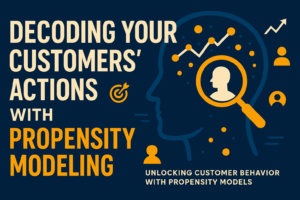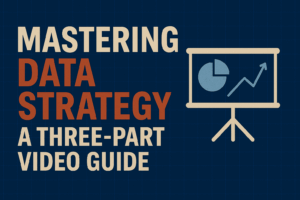Propensity models are a group of statistical models that provide immense value to your organization.
Read MorePropensity Models: Predict Customer Behavior With Data
Understanding customers that are likely to purchase is a fundamental component of an effective marketing strategy. By identifying these potential buyers, businesses can significantly enhance their marketing efforts, ensuring that messages are not only received but resonate with the audience most prepared to take action. This approach allows for a more efficient allocation of resources, targeting those at the tipping point of making a purchase and thereby increasing the likelihood of conversion. A common approach of identifying potential likely buyers is to use propensity modeling.
What is Propensity Modeling and How Does it Work?
Propensity modeling is a statistical technique that has become a pivotal tool in the data science arsenal, particularly when it comes to understanding and predicting customer behavior. At its core, propensity modeling involves leveraging historical customer data to predict the likelihood that a customer will demonstrate a specific behavior, such as making a purchase, referred to as propensity to buy, or opting out of a service, known as propensity to churn.
The use of propensity modeling allows businesses to not only collect relevant data but also refine their approaches to targeting specific customer segments with higher accuracy. A propensity model can be used to segment customers based on the customer’s higher propensity for certain actions, making it a powerful tool for tailoring marketing strategies. The benefits of propensity modeling are vast, allowing for a more targeted approach to marketing and customer retention strategies.
By understanding the specific needs and behaviors of their customer base, businesses can use propensity modeling to enhance customer satisfaction, optimize marketing expenditure, and increase overall revenue. Whether through improving product recommendations or identifying customers at risk of churning, propensity modeling is a powerful tool that leverages the rich insights hidden within customer data to predict customer behavior and drive strategic decisions.
Understanding the Basics of Propensity Models
Propensity models are statistical techniques used to predict various outcomes based on historical data. At their core, these models analyze data to predict whether a specific action will take place. For instance, a propensity model can be used to predict a customer behavior, such as the likelihood of a customer purchasing a product or service. This is done by analyzing past data and applying statistical algorithms to collect data on customer interactions and outcomes. Robust propensity models enable marketing and sales teams to more effectively target their efforts, ensuring resources are allocated towards individuals most likely to convert.
There are several types of propensity models, each designed with a specific goal in mind. For example, the propensity to churn model is utilized to identify customers who are most likely to end their business with a company, allowing the company to take preventative steps. On the other hand, the propensity to convert model focuses on predicting those who are more likely to complete a purchase. Data can come from various sources, and propensity models are typically built using a statistical techniques that learn how to calculate propensity scores, which are then used to rank individuals by their likelihood to perform a certain action; a higher score indicates a greater likelihood, whereas a lower propensity score suggests a lower chance.
Ensuring the accuracy of propensity models involves continuously refining the model to reflect new data and market conditions. The effectiveness of a model is significantly influenced by the quality and comprehensiveness of the input data. Ensuring the accuracy of propensity models is indeed a critical aspect that requires ongoing attention. These models, which predict the likelihood of a certain event happening, such as a customer making a purchase, are highly dependent on the data fed into them. The quality and comprehensiveness of input data, continuous refinement, and adaptation to new market conditions are key to maintaining and enhancing model performance. Here are three considerations when checking your data for accuracy.
- Correctness: The data must accurately represent the behaviors, characteristics, and outcomes it purports to measure. Inaccurate data can lead to misleading predictions.
- Relevance: The data should be closely related to the outcome you’re trying to predict. Including irrelevant data can dilute the model’s effectiveness.
- Completeness: Missing data can skew results. Use techniques such as imputation wisely to handle missing values without introducing bias.
By leveraging these techniques to predict customer behavior, companies can craft more personalized and effective marketing strategies. Over time, the goal is to ensure that the model remains precise in its predictions, assisting businesses in making informed decisions and optimizing their marketing efforts for better returns on investment. Ultimately, the power of propensity modeling use lies in its capacity to foretell customer actions, allowing for more targeted and effective marketing and sales strategies.
Types of Propensity Models and Their Applications
Propensity models are designed to predict the likelihood of a certain event happening, such as a customer making a purchase or a user engaging with a product. These models are used in various industries to enhance marketing strategies, improve customer relationships, and drive sales. At their core, propensity models analyze past customer behavior to estimate future actions. This method of propensity modeling is based on the creation of a propensity score, which measures the probability of an event occurring. Advanced statistical techniques are applied to achieve accurate propensity models that effectively identify individuals with higher propensity scores, indicating a greater likelihood of the predicted behavior.
To effectively implement these models, propensity modeling requires a comprehensive understanding of data analytics and pattern recognition. A comprehensive knowledge of data analytics helps an analyst select the proper propensity model technique to use. Among the different types of Propensity Models, the logistic regression model, a type of regression model, is commonly employed due to its simplicity and efficiency in calculating probabilities. However, for more complex predictions, propensity models can be considered that incorporate a variety of advanced machine learning techniques to handle large datasets and intricate patterns of behavior.
Propensity models can answer questions that are invaluable to a business. To showcase what types of questions a propensity model can answer, here are five use cases of propensity models.
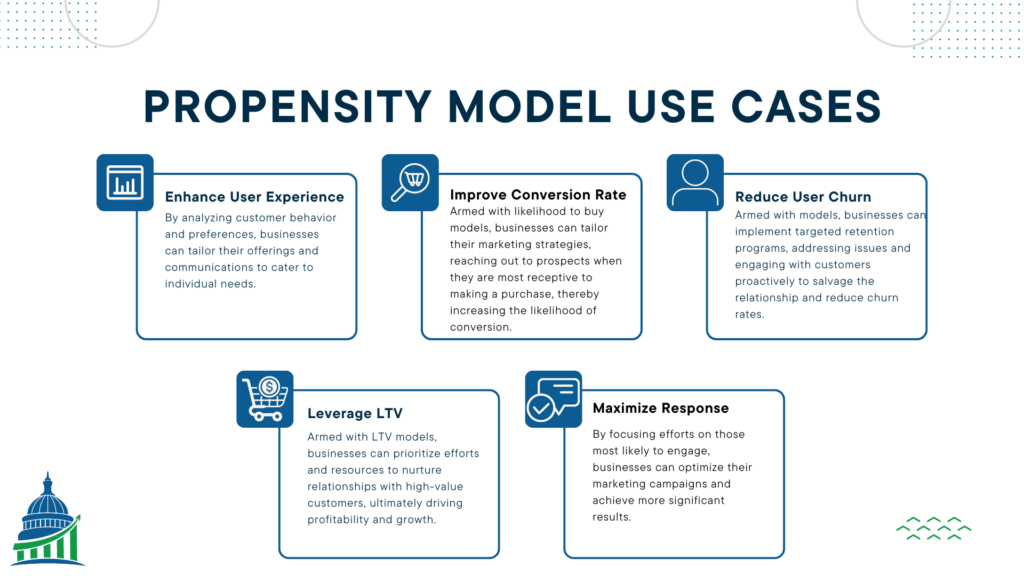
Ultimately, propensity modeling is used to guide decision-making processes and strategy development within organizations. By offering insights into customer behavior, businesses can optimize operations, reduce costs, and increase revenue. The main goal of these models is to identify potential actions and outcomes, making them invaluable tools for marketers and strategists alike. Whether improving customer retention rates or identifying potential sales leads, propensity models provide a sophisticated approach to predicting and influencing future behavior. As such, models that can be used to tap into this predictive power are increasingly sought after in the data-driven decision-making landscape.
Utilizing Historical Data in Propensity Modeling
Propensity modeling, a method used to predict the likelihood of certain outcomes based on historical data, has become a valuable tool in various fields. At its core, this approach assigns a score called a propensity score to each case by analyzing past behaviors and outcomes. This score is how a propensity model works, as it enables the prediction of future actions or decisions. By doing so, businesses can optimize their marketing strategies by focusing on individuals most likely to respond positively to their initiatives.
The predictive power of these models comes from their ability to discern patterns in the data that indicate a higher likelihood of a specific outcome. This enables organizations to make predictions on new data, guiding them in tailoring their approaches to meet consumer needs better. With various propensity scores, companies can segment their audience more accurately and thus direct their resources more efficiently.
To achieve accurate predictions, it’s crucial to make sure the data used is comprehensive and relevant. Since propensity models rely heavily on historical information, the quality of the predictions is directly tied to the quality of the data. Here are four sources of data that may be valuable for your propensity model.
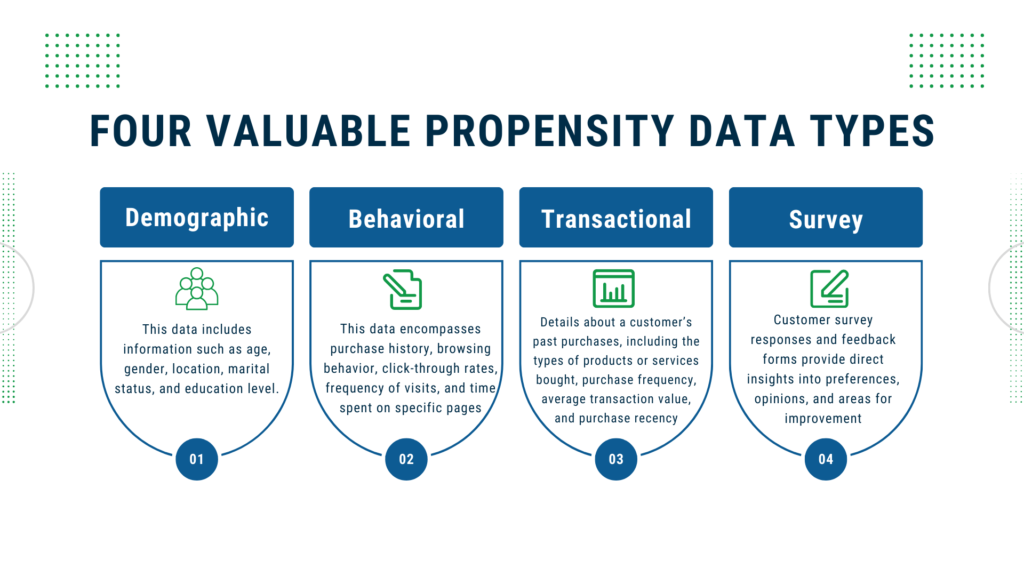
- Demographic Data: Understanding customer demographics is vital for tailoring products and services to specific target audiences. This data includes information such as age, gender, location, marital status, education level, and other relevant factors that help businesses cater to diverse customer needs effectively.
- Behavioral Data: Analyzing past actions and interactions with the company or website provides insights into customer behavior. This data encompasses purchase history, browsing behavior, click-through rates, frequency of visits, and time spent on specific pages, allowing businesses to personalize experiences and enhance customer satisfaction.
- Transactional Data: Details about a customer’s past purchases, including the types of products or services bought, purchase frequency, average transaction value, and purchase recency, offer valuable insights into consumer preferences and shopping patterns.
- Survey Data: Customer survey responses and feedback forms provide direct insights into preferences, opinions, and areas for improvement, guiding businesses in refining their offerings and enhancing customer experiences.
Benefits of Implementing Propensity Modeling
Propensity modeling is a powerful analytical technique used to predict the likelihood of individuals taking certain actions, like making a purchase or canceling a subscription. One of the primary benefits of implementing propensity modeling is the enhanced ability to target marketing and sales efforts more effectively. By understanding which customers are most likely to respond positively to specific campaigns, companies can allocate their resources more efficiently, leading to higher conversion rates and better ROI. This targeted approach not only optimizes marketing budgets but also improves customer experiences by delivering more relevant offers and messages.
Moreover, propensity modeling aids in early identification of at-risk customers, enabling proactive retention strategies. By predicting which customers are likely to churn, businesses can intervene early with tailored retention efforts, significantly reducing churn rates. Additionally, propensity models can uncover cross-sell and up-sell opportunities among existing customers, further increasing revenue potential. Lastly, the insights derived from propensity modeling can help in refining product development and innovation strategies by highlighting features or products that are likely to satisfy emerging customer needs, ensuring companies remain competitive in rapidly changing markets.
Benefits of Implementing Propensity Modeling
Propensity modeling is a powerful analytical technique used to predict the likelihood of individuals taking certain actions, like making a purchase or canceling a subscription. One of the primary benefits of implementing propensity modeling is the enhanced ability to target marketing and sales efforts more effectively. By understanding which customers are most likely to respond positively to specific campaigns, companies can allocate their resources more efficiently, leading to higher conversion rates and better ROI. This targeted approach not only optimizes marketing budgets but also improves customer experiences by delivering more relevant offers and messages.
Moreover, propensity modeling aids in early identification of at-risk customers, enabling proactive retention strategies. By predicting which customers are likely to churn, businesses can intervene early with tailored retention efforts, significantly reducing churn rates. Additionally, propensity models can uncover cross-sell and up-sell opportunities among existing customers, further increasing revenue potential. Lastly, the insights derived from propensity modeling can help in refining product development and innovation strategies by highlighting features or products that are likely to satisfy emerging customer needs, ensuring companies remain competitive in rapidly changing markets.
Enhancing Marketing and Sales Efforts with Propensity Models
Businesses are constantly searching for innovative ways to sharpen their marketing efforts and ensure their campaigns reach the right audience. One approach that stands at the forefront of this endeavor is the integration of predictive analytics through the use of propensity models. These models are designed to forecast the likelihood of specific behaviors among potential customers, such as the probability of making a purchase or the chance of responding to a particular marketing campaign. Below are two examples of how CDA helped businesses take advantage of propensity models that positively impacted their sales and marketing.
The below overview of a project that CDA completed shows how integrating propensity models into a sales team leads to better outcomes. In this case the sales team was only able to contact 1 out of 5 outbound leads. This lead to a lot of wasted effort trying to get leads on the phone. In order to improve the process, CDA incorporated CRM and transaction data to create a model that would prioritize leads that would likely pick up the phone. This prioritization of sales leads yielded a 10% increase in contact rate which also corresponded with an increase in sales.
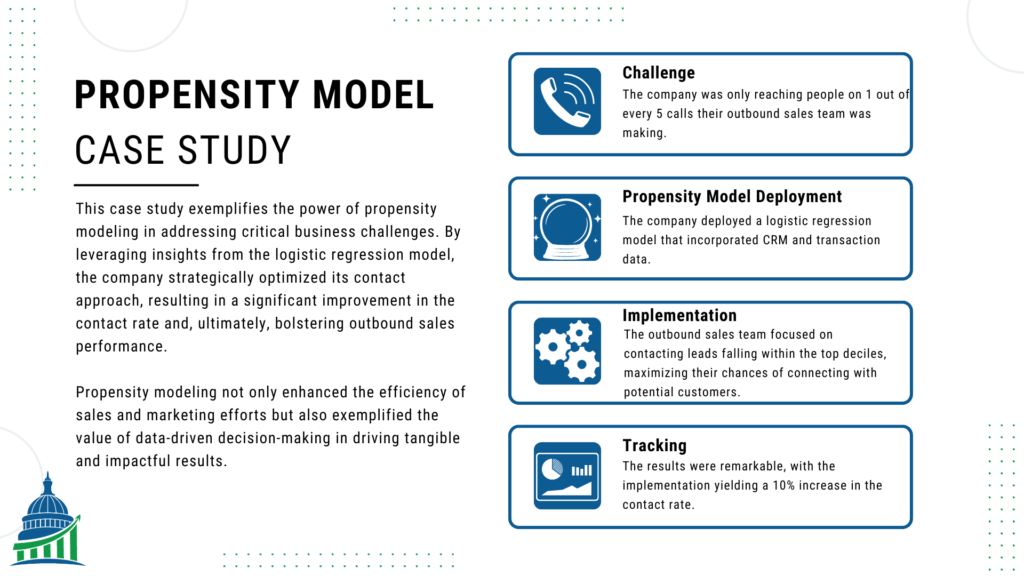
Below you see another example of the use of propensity modeling to predict a customer propensity score. This inbound sales and marketing team was inundated with new leads and was not able to expand their team to accommodate the amount of work needing to be done. Historical and Census data were fed into predictive modeling process that yielded propensity scores. These propensity scores were then used to prioritize the best leads for the sales team. The model process predicted the top decile of scores would have 3x the sales rate as the average sales rate before the propensity model was built.
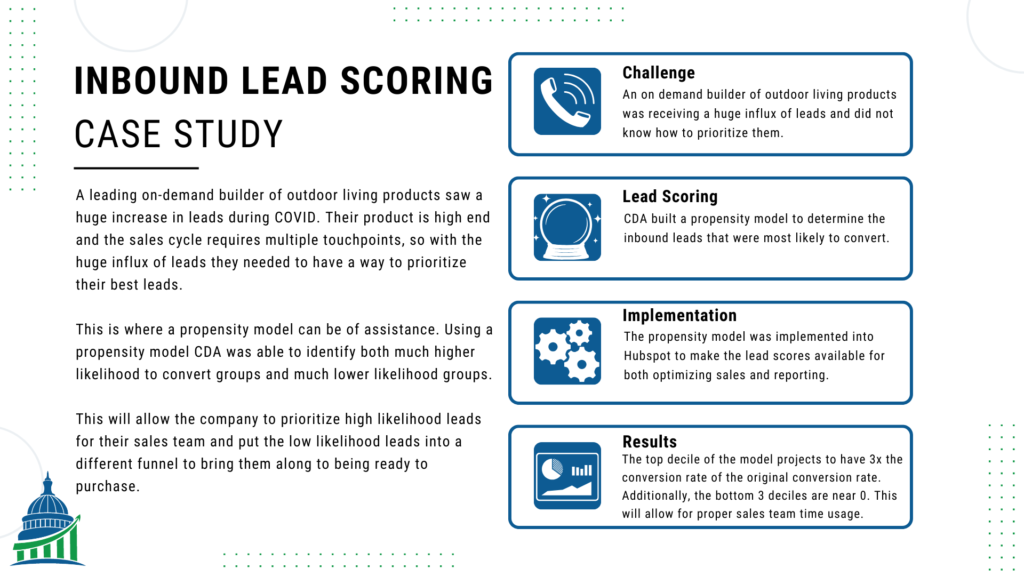
Challenges and Limitations of Propensity Modeling
Propensity modeling, a statistical model used widely across various industries for predicting the likelihood of certain outcomes based on historical data, faces several challenges and limitations. One of the significant hurdles is the quality and comprehensiveness of the input data. The accuracy of a propensity model heavily relies on the cleanliness, relevance, and completeness of the data fed into it. Insufficient or biased data can lead to skewed predictions, limiting the model’s applicability and reliability.
Another challenge is the dynamic nature of user behavior and external factors that can influence outcomes. These models, despite their sophistication, struggle to adapt quickly to sudden changes in market conditions or consumer preferences, making it difficult to maintain their accuracy over time. For this reason it is necessary to update these models on regular basis. A good time to do this would be every 1-2 years or after significant changes in the market environment.
Moreover, the complexity of creating and tuning a statistical model requires specialized knowledge and resources, which may not be readily available in all organizations. This expertise barrier not only hampers the initial development of the model but also its ongoing adjustment and improvement, further constraining its effectiveness and utility.
Overcoming Data Challenges in Propensity Modeling
Propensity modeling is an advanced analytical approach used to predict the likelihood of certain events or behaviors based on historical data and statistical algorithms. It plays a critical role in various industries, enabling businesses to make data-driven decisions. However, organizations face several data challenges when using propensity models. These challenges include the availability and quality of data, as data sets are often incomplete, inconsistent, or biased. To overcome these obstacles, companies must invest in data cleaning and preprocessing techniques to ensure the reliability and accuracy of their data. Additionally, concerns around privacy and data protection laws necessitate the implementation of strict data governance and ethical data use policies. To navigate these complexities, collaboration between data scientists, IT specialists, and legal experts is essential in overcoming the challenges of propensity modeling and leveraging its full potential for predictive insights.
Related Articles We Think You Would Enjoy Next
Mastering Data Strategy: A Three-Part Video Guide
A three video series that explores data strategy.
Read MoreWhy Do American-Made Brands Keep Losing Money to Hidden Wastage?
As an American-made manufacturer, you've relentlessly optimized your production line, yet three hidden wastage points beyond your view still threaten your profitability and even your business survival.
Read More